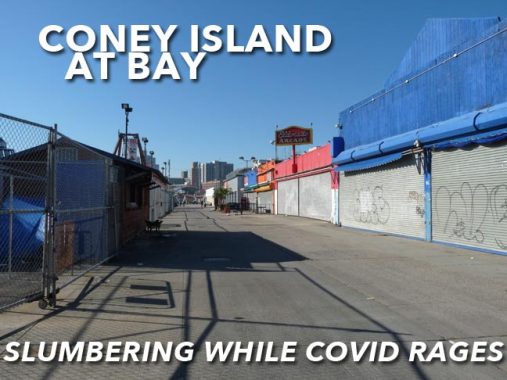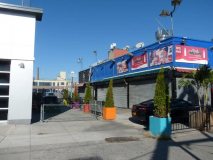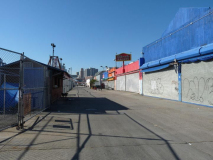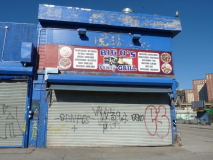
This week’s Sunday page is an expansion of an item I did for SpliceToday in November 2020. The month was pretty mild and I was in the mood for some Nathan’s, so down to the bottom of Brooklyn I went. After wandering around a near-deserted Coney (except for Nathan’s, which is always busy) I headed up Stillwell and then, since I’ve already covered 86th Street in what has inexplicably been FNY’s most commented-on article, I headed up 85th and 84th Streets to see some historic items in old New Utrecht at 18th Avenue.
The Coney Island subway terminal serves four subway lines, the D, F, N and Q, and from here you can reach far-flung locales in the Bronx, Brooklyn and Queens. Formerly a dingy, urine-spattered barn, the station had a multimillion-dollar makeover in the 2000s that gave it the look of a European train shed from a 1940s movie. The MTA got it right this time with this complete reconsideration. Take a look at some classic European rail stations, especially the ones in Milan and Madrid, they may have inspired this.
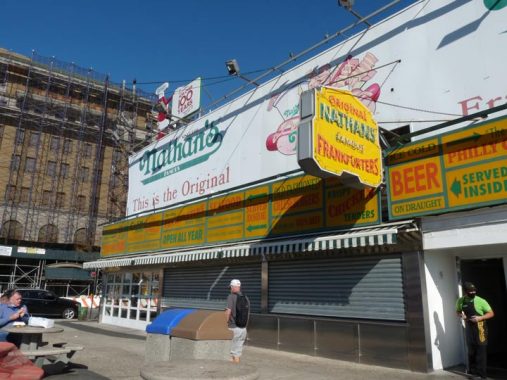
I am sitting in Schweickerts Alley, sometimes spelled Schweikerts, which is one of a series of alleys leading from Surf Avenue to the Coney Island boardwalk; formerly, they were bustling with food vendors and amusements in the Brooklyn Riviera, NYC’s seaside playground. These days, Schweickerts Allley serves as the outdoor sitting area for Nathan’s Famous, and that’s where I had my hot dog and fries on this 65-degree November day. Why not?
Though Coney was at bay for much of 2020, no Mermaid Parade, no rides, Nathan’s was still going strong and on a recent visit I waited 10 minutes on line for my hot dog and fries. On July 4th, professional gourmand Joey Chestnut again claimed the mustard-colored belt in the Nathan’s Hot Dog Eating Contest, this year held remotely without spectators.
In 1916, an employee of Charles Feltman, the original hot dog purveyor of Coney, Nathan Handwerker, struck out on his own, renting a shack at Surf and Stillwell Aves. and sold hot dogs by the nickel. In the early years business was slow. Handwerker hit on the gimmick of dressing some local layabouts in white smocks, set them up behind the counter selling franks, and advertising his hot dogs approved by “doctors.” With the arrival of the BMT subway in 1920, his location proved advantageous and he was soon selling thousands, then millions, of hot dogs. Seafood items and other food were added to the menu and Nathan’s became a familiar institution.
Coney Island’s Bowery (until recently called Bowery Street on DOT street signs) is a quiet pedestrian walkway at least in the off season. Today it was seemingly as silent as the tomb. But in the early to mid 20th Century it was quite raucous indeed:
The most famous section of West Brighton was an area known as the Bowery. The Bowery was south of Surf Avenue and extended from Jones Walk, on the west side of Feltman’s, to West 16th Street, on the east side of Steeplechase Park. Its main drag, known as Ocean Avenue until around 1905 and as Bowery Lane thereafter, ran parallel to Surf Ocean and about 65 yards south of it. The Tilyou and Stratton families had leases to much of the land, and they are believed to have originally constructed a boardwalk along this lane, which was later replaced by a paved walk. The original name of Ocean Avenue must have led to some confusion in the Postal Service as there was another Ocean Avenue in nearby Sheepshead Bay.
The Bowery was a raucous area where police frequently looked the other way as drinking, gambling, music and shows took place well into the night. Coney Island’s appeal was that anyone could find the type of experience they desired. For those looking for more variety and fun, and less refinement, the Bowery stood head and shoulders above Brighton Beach and Manhattan Beach. [Heart of Coney Island]
Denos Vouderis’ Wonder Wheel stood alone on a deserted West 12th Street. It opened on Memorial Day 1920 and was built by the Eccentric Ferris Wheel Company using 100% Pennsylvania steel. It stands 150 feet tall and weights 200 tons. There are 24 cars, 16 of which swing: eat lunch after you ride on one of the swinging cars. For awhile, it was going to be dethroned by a 60-story Ferris wheel in Staten Island, but those grand dreams went kaput.
The Cyclone roller coaster, opened on Surf Ave. and W. 12th St. in the summer of 1927. It’s one of the few wooden construction ’coasters still in operation and, I hear, provides a thrilling ride. It has operated continuously except for four years between 1971 and 1975; after that, Dewey and Jerome Albert, owners of Astroland Park, rehabilitated it and safely operated it till the demise of Astroland in the 2000s. A revived Luna Park continued its operations beginning in 2011.
I’ve been too chicken for the more challenging roller coasters, afraid my glasses will fly off. As a matter of fact, I’ve only been on one roller coaster in my life, the indoor one at the Mall of America in Minneapolis, and I endured the ride rather than enjoyed it.
Don’t worry, in a really dangerous situation I imagine I’d do what must be done.
The oldest extant building in Coney Island at Surf Ave. and Jones Walk is a former hardware store built in the 1880s and operated by Henry Grashorn for decades beginning in 1898. Hardware was necessary in Coney to fix the numerous mechanical parts in the rides and attractions. Grashorn became one of Coney’s prominent citizens and was the president of Coney Island’s Mardi Gras Association, which ran an annual parade in the fall between 1903 and 1954, a tradition revived as the Mermaid Parade in the 1980s at the outset of summer.
Today the building has been stripped, leaving its old wooden construction bare, and reports say its demolition is imminent.
I wonder who has the key…
The building at Surf Avenue and West 12th Street was originally constructed in 1917 in the Spanish Colonial Revival style for the Childs restaurant chain, a cafeteria-style restaurant founded in the 1880s in lower Manhattan which eventually grew to have over 100 locations in America and Canada. This building was the first of two Childs restaurants constructed in Coney Island; the other building on the Boardwalk was designated a landmark in 2003.
Today it’s home to Sideshows By the Seashore and the Coney Island Museum, as well as offices of Coney Island USA, which runs the Mermaid Parade in June.
These terrific green, red and white terra cotta panels date to the original Stillwell Avenue Brooklyn-Manhattan Transit station, constructed in 1920 and allowed to completely disintegrate before it was completely rebuilt in the early 21st Century.
The Stillwell train shed looks as good from the outside, at Stillwell and Mermaid Avenue, as it does from the inside. I’d like to see a documentary on the conception of this crown jewel of southern Brooklyn.
Brooklyn contains many inlets and waterways, such as the noxious Newtown Creek, the gooey Gowanus Canal, and the contaminated Coney Island Creek, which Stillwell Avenue crosses on a rather ordinary steel and concrete fixed span.
This is a good time to mention that while Coney Island isn’t actually an island any more, it used to be. It was the westernmost of the barrier islands off the southern coast of Long Island, separated from Long Island by Coney Island Creek, which ran from Gravesend bay on the west to Sheepshead Bay on the east. Part of it was little more than tidal flats. Officials at one time considered dredging and straightening it for a ship canal, as was done on the Harlem River, but instead it was filled in between Shell Road and East 15th St. in the 1930’s as the Belt Parkway was being constructed. But the name Coney Island remained, as Coney Peninsula doesn’t have that same ring. Long Distance Voyager
The creek is also famed for its Yellow Submarine.
Today, Stillwell Avenue crosses the Creek on a fairly boring fixed bridge with a tall cyclone fence that makes it tough to get a photo of the Creek (see above), but that wasn’t the case in the 1980s, when a truss bridge was in place. Photo: Bernard Ente
A concrete plant, Stillwell Ready Mix, occupies the east side of Stillwell Avenue, along with a retail hardware store, Stillwell Materials, between the Belt Parkway and Harway Avenue.
“Dirty, disgusting, filthy, lice-ridden birds.” Stillwell Avenue and Avenue Z.
Well, probably not.
If there were a commissioner for pigeon racing in the five boroughs of New York, in recent years that title would have gone to Frank Viola. Mr. Viola, a slight, white-haired man from Bath Beach, Brooklyn, founded his namesake club in the early 1990s and ran the Frank Viola Invitational for the last 16 years [in 2007]. With 1,500 birds, the race became one of the largest in the city, the Kentucky Derby of the pigeon season. New York Times
I’ve encountered the Viola Homing Pigeon Club before, at the west end of Avenue Z at Cropsey Avenue.
At Stillwell and Harway Avenues, a B train works the elevated West End line. It’s visiting its old home, since for the past couple of decades the B, which only runs weekdays, is the express train on the Brighton line, with the Q the local. The B crosses the Manhattan Bridge and runs up 6th Avenue, 53rd Street and Prospect Park West.
Here, the Stillwell Avenue el ducks into the Coney Island Yards, which is what (I think is) the largest subway yard in the system, serving trains running in southern Brooklyn. Periodically the Transit Museum offers tours of the vicinity since the subways’ vintage fleet does a lot of repair and maintenance there.
At Stillwell and Harvey I also found this abandoned school bus. I am aware school buses haven’t had much of a workout during the Age of Covid, but this is pretty extreme.
Here we are at the Bay 50th Street station which is significant for me for two reasons. One, this was the starting point of one of the great car chases in filmdom. Few films contain more recent “forgotten” New York scenes than 1971’s The French Connection. Extensive on-location shooting along with director William Friedkin’s penchant for showing the gritty realism of the city make this one of the easiest ways to see what New York was like circa 1970. Winner of five Oscars, including Best Picture, The French Connection is often remembered for what might be the most incredibly staged car chase on film, as detective Jimmy “Popeye” Doyle, played by Gene Hackman, desperately pursues drug smuggler Nicoli (Marcel Bozzuffi) aboard an out-of-control subway train along the West End el branch by driving down Stillwell Avenue, 86th Street and New Utrecht Avenue at breakneck speed, a scene that was filmed without official sanction in real time with stunt driver Bill Hickman narrowly missing pedestrians along the way.
The other reason Bay 50th is significant for me is quite esoteric. Well into the 1970s and even perhaps the early 1980s, Stiillwell Avenue was lit under the el at Bay 50th by incandescent Westinghouse “cuplights” attached to the el. After that the DOT removed them and placed streetlamps on telephone poles, such as the one seen here.
Lafayette Educational Campus, at Benson and Stillwell Avenues, opened as Lafayette High School in 1939 with the original school dividing into several smaller schools after 2020. There are two architecturally identical high schools: Christopher Columbus in Allerton, Bronxl and William Cullen Bryant in Long Island City. Famed alumni include a dozen ex-major league baseball players, including the Mets’ John Franco and the Dodgers’ Sandy Koufax; actors Paul Sorvino and Rhea Perlman; talk show host Larry King; and pop artist Peter Max.
Aross the street, Lafayette Playground was given a handsome makeover in 2019 by MKW Landscape Architects. This part of Bath Beach isn’t lacking in public recreational facilities, since Scarangella Park is directly across the street. That park was built in 1930 and was formerly known as Lafayette High School Park until the 1980s, when it was named for Police Officer John Gerard Scarangella (1940-1981) who grew up in Gravesend and was murdered while on duty in 1981. The park’s NYC Parks profile gives a capsule history of Gravesend.
Walking northwest up 85th Street we have crossed over into Bensonhurst. Many of the houses are either attached frame buildings or attached brick, but you occasionally get freestanding homes like this gabled house.
The saucer has landed! You wouldn’t think so from the ultramodern church building, but the Catholic St. Mary Mother of Jesus parish, 23rd Avenue and 85th Street, is among Brooklyn’s oldest, as it was established in 1889 with its first services held in a Liggett drugstore. The parish’s brick church (see here in a Municipal Archive photo) burnt down in 1967 and was replaced with this moderne classic that was being worked on when I passed it in November. Though the cornerstone reads 1970, the church’s website says it was dedicated in 1968.
The brick parish school was built in the 1910s. It is now called the St. Peter Catholic Academy, as three local parish grade schools were consolidated there. St. Peter, an Apostle and the first pope, is represented by a pair of crossed keys symbolic of the office: “I will give you the keys of the kingdom of heaven, and whatever you bind on Earth shall be bound in heaven, and whatever you loose on Earth shall be loosed in heaven.” [Jesus, in Matthew 16:19]
8418 Bay Parkway has been a Chase bank for a long time: this Archives photo from 1980 shows it as a Chemical branch, which was later acquired by Chase. Often, banks have standalone lampposts on adjoining sidewalks, likely to discourage nighttime break-ins.
Bay Parkway has stood in for 22nd Avenue on the Brooklyn map for over a century (see this 1922 Hagstrom). For a long time, though, the Bay Parkway station on the West End el at 86th was signed “22nd Avenue.” The parkway is alternately commercial and residential. Between 65th Street and Avenue P, it’s the divider between the old City of Brooklyn numbered streets and the former Town of Flatbush’s West numbered streets. Here is a grand old Deco apartment house at Bay Parkway and 84th Street.
Another Deco entrance at #2020 84th Street.
The SE corner of 20th Avenue and 84th Street is dominated by a huge apartment building, The Columbus, at #2000 84th. At the entranceway is a pair of terra cotta plaques depicting Columbus’s coat of arms and his flagship, the Santa Maria.
New Utrecht Reformed Church
I enjoy this building at the heart of the Town of New Utrecht so much, for both the architecture and the history, I shot it from several different perspectives and included its historic plaque and year of construction. In 2020 we were going to do a Forgotten Tour in this neck of Brooklyn and I hope to be able to get us inside when live tours resume.
The heart of New Utrecht has always been the two sites of the New Utrecht Reformed Church. The first church in New Utrecht was first built about 1699 (the congregation dates to 1677) and stood at what would be 16th Avenue at about 85th Street. This original church no longer stands, but its ancient churchyard can still be found there (see below).
A “newer” church, this one, was built in 1828 at what would become 18th Avenue and 84th Street but what was then at the crossroads of the Road from New Utrecht to Flatbush (now 18th Avenue) and KIngs Highway (part of it survives as the wider section of 84th Street between 16th and 18th Avenues) and contains some stones from its predecessor, along with Tiffany style stained glass. The bell of the two New Utrecht Reformed Churches has tolled to mark the death of every U.S. President…beginning with George Washington in 1799… and in the 1990s rung to mark the deaths of Joe DiMaggio and Frank Sinatra (the neighborhood of Bensonhurst that surrounds the church had been mostly Italian, until recent years).
The church parish house on 84th Street is nothing to be slouched at itself as the Shingle Style building was constructed in 1885. The asymmetrical design was executed by architect Lawrence Valk.
Read all about both buildings in the Landmarks Preservation Commission report.
To harass the British, or to signal their defeat, Colonial patriots erected “liberty poles” on which the new American flag was raised. The first such pole in New Utrecht was raised in 1783 to celebrate American victory at the end of the Revolutionary War and the evacuation of the British from New York, which happened at the Denyse Ferry in Bay Ridge. Six poles have been placed here subsequently; this latest pole was raised in 1946. The pole stands on what was Van Pelt Manor, which had been settled by the Van Pelt family in the 1670s and used as a military prison during the Revolutionary War. The manor was deeded to the city by the family in 1910, on the condition that the city preserve an ancient Dutch milestone that stood on the property. That stone is now in the Brooklyn Museum and is recollected by Milestone Park a block away on 18th Avenue.
It’s a weedy expanse fronting 16th Avenue between 83rd and 84th Street with a chain link fence that’s practically never open. Inside you will find gravestones nearly all of whose inscriptions face east, away from whatever purchase you can get on them with a camera. Ignored for the most part by Bensonhursters, this is one of the oldest remnants of European civilization in Brooklyn as it’s a burying site established in 1654 — even before the Reformed Church congregation arose in 1677 and took over the grounds.
It includes the family plots of the earliest New Utrecht families, including the Van Brunts, Cortelyous, Cowenhovens, Cropseys, and Bennetts; a communal, unmarked grave of American Revolutionary War soldiers; and an area near the intersection of today’s 16th Avenue and 84th Street where church members of African descent (both slave and free) were buried. Approximately 1,300 people have been interred in the cemetery during the past three centuries. [LPC report]
An old church stands adjacent to the cemetery. Visitors to the area sometimes mistake it for the Reformed Church, but this is the former St. John Reformed German Evangelical Lutheran Church consecrated in 1898. Since 1974 it has been the Metropolitan Baptist Church; the Reformed Church stood here only until 1827. From 1776-1783, British troops occupied the site and it was here that patriot General Nathaniel Woodhull was detained. According to legend, but in an undocumented story, he was struck by a British officer after refusing to utter the phrase “God save the king.” He later died of wounds suffered in captivity.
Welcome back! New Utrecht High School was established in 1915 and built this large school building, its size since increased by annexes, in 1924. At one point there were 11,000 students in grades 9-12. Famous and infamous alumni include actor Gene Barry, mobster Joseph Colombo, record mogul David Geffen and “Mr. Kotter” Gabe Kaplan. In fact, exterior shots for the title sequence of Welcome Back, Kotter were filmed at NUH.
Time to kick it in the head and get the D train back to the Shining City at the 71st Street station.
Check out the ForgottenBook, take a look at the gift shop, and as always, “comment…as you see fit.”
12/27/20
